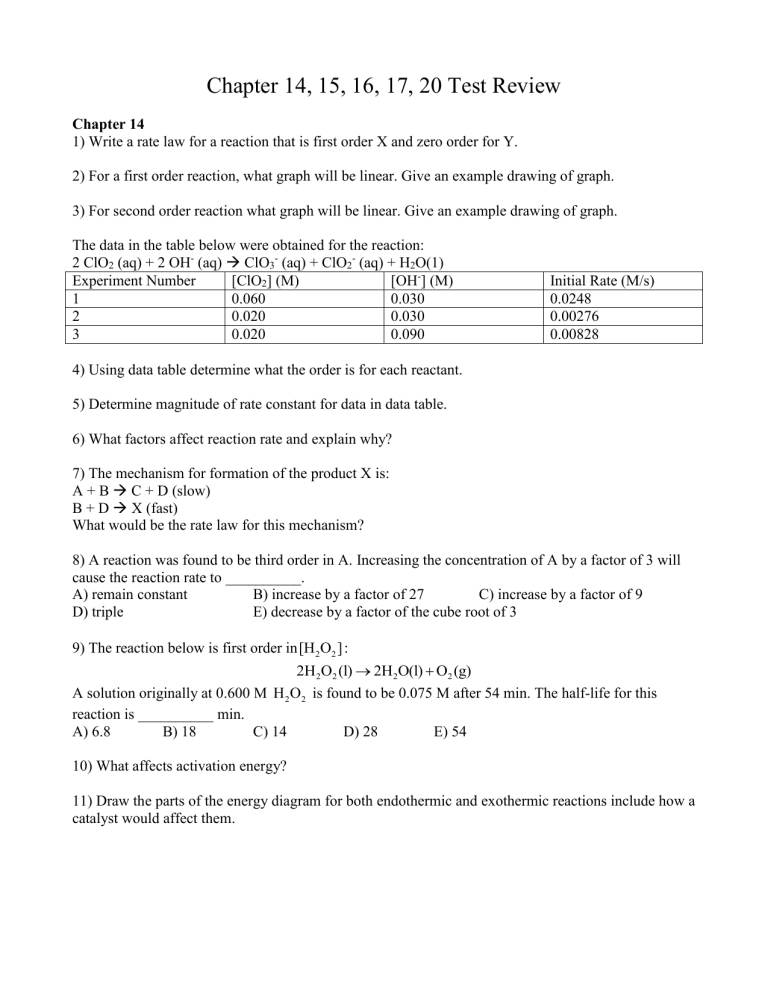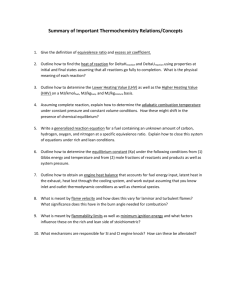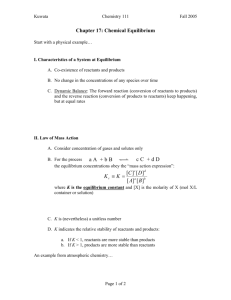Review for Chapter 14, 15, 16, 17 and 20

Chapter 14, 15, 16, 17, 20 Test Review
Chapter 14
1) Write a rate law for a reaction that is first order X and zero order for Y.
2) For a first order reaction, what graph will be linear. Give an example drawing of graph.
3) For second order reaction what graph will be linear. Give an example drawing of graph.
The data in the table below were obtained for the reaction:
2 ClO
2
(aq) + 2 OH
-
(aq)
ClO
3
-
(aq) + ClO
2
-
(aq) + H
2
O(1)
Experiment Number [ClO
2
] (M) [OH
-
] (M)
1
2
0.060
0.020
0.030
0.030
Initial Rate (M/s)
0.0248
0.00276
3 0.020 0.090
4) Using data table determine what the order is for each reactant.
5) Determine magnitude of rate constant for data in data table.
6) What factors affect reaction rate and explain why?
7) The mechanism for formation of the product X is:
A + B
C + D (slow)
B + D
X (fast)
What would be the rate law for this mechanism?
0.00828
8) A reaction was found to be third order in A. Increasing the concentration of A by a factor of 3 will cause the reaction rate to __________.
A) remain constant
D) triple
B) increase by a factor of 27 C) increase by a factor of 9
E) decrease by a factor of the cube root of 3
9) The reaction below is first order in :
2H O (l)
A solution originally at 0.600 M H O
2
is found to be 0.075 M after 54 min. The half-life for this reaction is __________ min.
A) 6.8 B) 18 C) 14 D) 28 E) 54
10) What affects activation energy?
11) Draw the parts of the energy diagram for both endothermic and exothermic reactions include how a catalyst would affect them.
Chapter 15
12) Acetic acid is a weak acid that dissociates into the acetate ion and a proton in aqueous solution:
HC
2
H
3
O
2 (aq)
C
2
H
3
O
2
-
(aq)
+ H
+
(aq)
At equilibrium at 25 °C a 0.100 M solution of acetic acid has the following concentrations:
[HC
2
H constant,
A) 5.71
3
O
K
2
]
0.0990M
eq
[C
2
H
3
O
2
]
1.33
10
3 M and [ H
1.33
10
, for the ionization of acetic acid at 25
C is __________.
10
4
B) 0.100 C) 1.75
10
7 D) 1.79
10
3
5
M The equilibrium
E) 5.71
10
6
13) What is the equilibrium constant, K eq
, for the reverse reaction?
14) The equilibrium-constant expression depends on the __________ of the reaction.
A) stoichiometry B) mechanism C) stoichiometry and mechanism
D) the quantities of reactants and products initially present E) temperature
15) Which of the following expressions is the correct equilibrium-constant expression for the reaction below?
(NH
4
)
2
Se
(s)
2NH
3(g)
+ H
2
Se
(g)
A) K c
= [NH
3
][H
2
Se] / (NH
C) K c
= 1/[(NH
4
)
2
Se]
4
)
2
Se
D) K c
= [NH
3
] 2
B) K c
= (NH
[H
2
Se]
4
)
2
Se / [NH
3
] 2 [H
2
Se]
E) K c
= [NH
3
] 2 [H
2
Se] / [(NH
4
)
2
Se]
16) The equilibrium constant for the gas phase reaction is K eq
2NH
3(g)
N
2(g)
230 at 300 °C. At equilibrium, __________.
+ 3H
2(g)
A) products predominate B) reactants predominate
C) roughly equal amounts of products and reactants are present
D) only products are present E) only reactants are present
17) If equal volumes of all three gases from the equation above were put into a sealed container. What would happen to the concentrations of each gas as the system moved toward equilibrium? What about the pressure? Why?
18) If the reaction went to completion how would the final pressure compare to the initial pressure?
19) What would the ∆G
◦
be for the reaction in 16?
20) For the endothermic reaction
CaCO
3(s)
CaO
(s)
+ CO
2(g)
Le Chatelier's principle predicts that __________ will result in an increase in the number of moles of CO
2
.
A) increasing the temperature
C) increasing the pressure
B) decreasing the temperature
D) removing some of the CaCO
3
(s)
E) none of the above
21) Consider the following reaction at equilibrium:
2NH
3(g)
N
2(g)
+ 3H
2(g)
ΔH° = +92.4 kJ
Le Chatelier's principle predicts that adding N
__________.
2
(g) to the system at equilibrium will result in
A) a decrease in the concentration of NH
3
(g)
C) an increase in the value of the equilibrium constant D) a lower partial pressure of N
E) removal of all of the H
2
(g)
B) a decrease in the concentration of H
2
(g)
2
Chapter 16 and 17
22) What are the strong acids? What about strong bases? What does this means?
23) The conjugate base of HSO4- is
A) H
2
SO
4
B) SO
4
2-
C) H
3
SO
4
+
D) HSO
4
+
E) OH
-
24) The conjugate acid of HSO4- is
A) H
+
B) H
2
SO
4
C) HSO
4
+
D) SO4
2-
E) HSO
3
+
25) What is the pH of an aqueous solution at 25
◦
that contains 3.98 X 10
-9
M hydronium ion?
A) 7.000 B) 9.000 C) 8.400 D) 5.600 E) 3.980
26) Draw a titration curve for an acid being titrated by a base. Label the equivalence point and half equivalence point. What particles would you find and how do the concentration of reactants and products compare on various points on the graph, such as before half equivalence point, at half equivalence point, between half equivalence and equivalence, at equivalence point, and well beyond equivalence point.
27) How do you figure out the unknown concentration of acid or base in a titration?
28) What creates a buffer? What happens to the pH of a buffer when an acid is added?
29) Which one of the following is the weakest acid? Which one would have the lowest pH if all concentration were the same?
A) HF (Ka = 6.8 X 10
-4
)
B) Acetic acid (Ka = 1.8 X10 -5 )
C) HNO
2
(Ka = 4.5 X 10
-4
)
D) HClO (Ka = 3.0 X 10
-8
)
E) HCN (Ka = 4.9 X 10 -10 )
30) Which one could create a buffer with a pH closest to 7? And what two species would be present in that buffer?
31) What is the pH of a weak base with a K b
=3 X 10
-5
with a concentration of 0.020 M?
Chapter 20
32) A cell is constructed by immersing a strip of lead in a 1.0 M Pb(NO3)2 solution and a strip of silver in a 1.0 M AgNO3 solution. The circuit is completed by a wire and a salt bridge. As the cell operates, the strip of silver gains mass (only silver), and the concentration of silver ions in the solution around the silver strip decreases, while the strip of lead loses mass, and the concentration of lead ions increases in the solution around the lead strip. Which of the following represents the reaction that occurs at the cathode in this cell?
A) Pb2+ + 2e- → Pb
B) Pb → Pb2+ + 2e
D) Ag → Ag+ + e
E) none of the above
C) Ag+ + e- → Ag
33) What is the numerical value for the standard cell potential for the following reaction?
2Cr3+(aq) + 3Cu(s) → 2Cr(s) + 3Cu2+(aq)
A) -1.08 V B) -0.40 V C) 0.40 V D) 1.08 V E) 2.52 V
34) What would be the cathode and what would be the anode in the above reaction? Which electrode would reduction be occurring and which would oxidation?
35) How does increasing the concentration of Cu2+ solution affect the cell potential? What about increasing the concentration of Cr3+ solution?
36) If you are given two reactions with known cell potentials and one with an unknown cell potential, how do you determine the unknown cell potential?
37) Calculate ∆G 0 for the reaction in #33.








